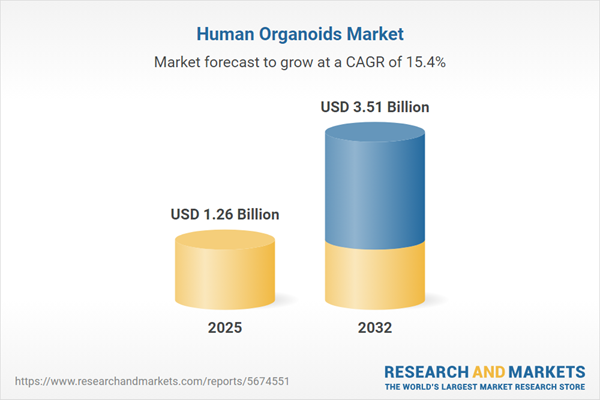Speak directly to the analyst to clarify any post sales queries you may have.
The human organoids market empowers senior leaders in biotech and pharmaceutical industries to accelerate biomedical discovery and clinical innovation using scalable, advanced 3D tissue models. Integration of organoid technologies enhances operational workflows, supporting organizations navigating the complexities of the global research landscape.
Market Snapshot: Human Organoids Market Size and Growth
The human organoids market is witnessing sustained expansion, reflected in its substantial total addressable market and a strong compound annual growth rate throughout the forecast period. Leading pharmaceutical and biotech companies, as well as global research organizations, are increasingly adopting organoid models to refine preclinical research accuracy and compress drug development cycles. Strategic investment in next-generation organoid technologies continues to propel advancements in disease modeling and therapeutic research. The rapid uptake of innovative tissue platforms and the growing need for reliable research tools are reinforcing ongoing market growth and momentum.
Scope & Segmentation of the Human Organoids Market
Effective market segmentation drives tailored innovation, improves regulatory alignment, and focuses operational efforts. Understanding each segment enables decision-makers to target resources and strategies that correspond with shifting market needs. Key market areas include:
- Organoid Types: Models for brain, cardiac, intestinal, kidney, liver, lung, and pancreas research support wide-ranging applications in disease modeling, regenerative studies, and the development of targeted therapies.
- Cellular Sources: Organoids developed from adult stem cells, pluripotent stem cells, and embryonic tissues provide versatility for fundamental research, translational activities, and clinical pathway advancement.
- Enabling Technologies: The use of 3D bioprinting, hydrogel-based systems, specialized scaffolds, and advanced cell culture techniques promotes data quality, reproducibility, and efficiency throughout research workflows.
- Applications: Adoption spans drug discovery, toxicity assays, infectious disease investigations, oncology, neurobiology, regenerative medicine, and the pursuit of personalized therapies, reflecting current research and clinical priorities.
- End User Segments: Biotechnology companies, pharmaceutical multinationals, academic research institutions, and specialized laboratories each require distinct integration strategies and regulatory support approaches.
- Geographic Regions: The Americas, Europe, Middle East and Africa, and Asia-Pacific are core regions, each shaped by unique regulatory systems, infrastructure maturity, and technology adoption rates which influence overall market direction.
- Company Landscape: Organizations such as Corning Incorporated, Thermo Fisher Scientific Inc., Miltenyi Biotec, and F. Hoffmann-La Roche Ltd. play central roles in advancing the field through investment in R&D and collaborative initiatives.
Key Takeaways for Senior Decision-Makers
- Implementing cutting-edge 3D bioprinting and hydrogel systems significantly improves reproducibility, supporting rigorous validation in both research and commercial environments.
- Maintaining a broad selection of organoid models allows organizations to adapt swiftly to changing clinical priorities and the emergence of new therapeutic research areas.
- Robust collaboration among industry leaders, academic institutions, and laboratory services facilitates faster innovation and accelerates the translation of findings into practical clinical applications.
- Developing resilient supply chains using local sources minimizes the risk from regulatory changes and logistical challenges, supporting operational stability across diverse markets.
- Advancements in laboratory automation and analytics, particularly within the Asia-Pacific region, enable more effective integration of next-generation technologies and resource allocation.
- Strengthening compliance programs and investing in quality assurance drive scalable laboratory operations and reinforce organizational credibility in international settings.
Tariff Impact: Navigating Global Disruptions
Recent U.S. tariffs have increased costs and affected sourcing strategies for key reagents and bioreactor technologies in the human organoids market. To maintain flexibility, many organizations have diversified supply chains and invested in domestic production capacity, enabling continued research and minimizing disruption from regulatory volatility.
Methodology & Data Sources
This market assessment is based on peer-reviewed publications, patent databases, and regulatory filings, augmented by insights from expert interviews and industry workshops. Such a multi-sourced approach ensures comprehensive trend validation and supports strategic planning for senior leadership teams.
Why This Report Matters
- Delivers actionable insights and well-defined segmentation strategies to guide data-driven, long-term organizational planning in the human organoids market.
- Arms senior executives with tools to anticipate evolving regulatory requirements, technology shifts, and procurement challenges, maintaining a competitive market stance.
- Supports resource prioritization for organoid-based innovations with the capacity to yield valuable operational and clinical results.
Conclusion: Strategic Pathways Forward
By prioritizing investment in organoid research platforms and fostering cross-sector collaboration, organizations position themselves to harness new market opportunities and navigate transformation in biomedical and clinical development.
Additional Product Information:
- Purchase of this report includes 1 year online access with quarterly updates.
- This report can be updated on request. Please contact our Customer Experience team using the Ask a Question widget on our website.
Table of Contents
3. Executive Summary
4. Market Overview
7. Cumulative Impact of Artificial Intelligence 2025
List of Figures
Companies Mentioned
The companies profiled in this Human Organoids market report include:- Corning Incorporated
- Bio-Techne Corporation
- 3Dnamics Inc.
- AIVITA Biomedical, Inc.
- BICO Group AB
- BrainZell
- Cannex Scientific, Inc.
- CN Bio Innovations Limited
- DefiniGEN Limited
- F. Hoffmann-La Roche Ltd.
- HeartBeat.bio AG
- Herophilus
- HUB Organoids B.V.
- InSphero AG
- Kirkstall Ltd.
- Merck KGaA
- Miltenyi Biotec B.V. & CO. KG
- Mimetas BV
- Molecular Devices, LLC by Danaher Corporation
- Organovo Holdings Inc.
- Pandorum Technologies Pvt. Ltd.
- Rumi Scientific, Inc.
- STEMCELL Technologies Canada Inc.
- SUN bioscience SA.
- Thermo Fisher Scientific Inc.
- ZenBio, Inc.
Table Information
| Report Attribute | Details |
|---|---|
| No. of Pages | 184 |
| Published | November 2025 |
| Forecast Period | 2025 - 2032 |
| Estimated Market Value ( USD | $ 1.26 Billion |
| Forecasted Market Value ( USD | $ 3.51 Billion |
| Compound Annual Growth Rate | 15.4% |
| Regions Covered | Global |
| No. of Companies Mentioned | 27 |









